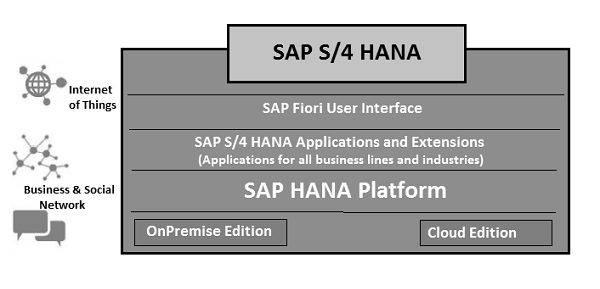SAP S/4 Hana Tutorials: Simple logistics Introduction
SAPチュートリアル
SAP Simple Logistics is also called SAP S/4 HANA Enterprise Management. It consists of all the key modules under SAP ERP Business Suite - Material Management, Supply Chain, Demand Planning, Sourcing and Procurement, Contract Management, and Manufacturing.
Following business processes can be managed using SAP S/4 HANA Enterprise Management with improved performance and efficiency for all these processes −
- Inventory Management − SAP S/4 HANA Enterprise Management provides a simplified data model resulting in increased throughput and flexible analytics at the most granular level.
- Procurement − With SAP S/4 HANA Enterprise Management, you can achieve increased efficiency in the Procure-To-Pay processes, new Analytical Apps and Spend KPIs, Ariba Network Integration for PO Order and IV.
- Material Requirements Planning − You can perform fast MRP run, and a new working model for MRP controllers based on decision support.
- Order Management & Billing − Using S/4 HANA Enterprise Management, you can perform end-to-end order-to-cash process and take action for any exceptions, information on the exceptions to resolve the issues, lower TCO due to data model simplification, support for the most recent versions of business features such as FSCM Credit Management, GTS Foreign Trade, SFIN Revenue Accounting, and new analytical capabilities.
ERP Model vs S/4 HANA Data Model
To manage large volumes of data, SAP has provided next generation Business Suite S/4 HANA, which uses computing power of HANA to process huge amounts of data at very high speed.
SAP S/4 HANA is not a successor of SAP ERP solution and represents a separate product line. SAP ERP solution is a separate product from SAP. With new S/4 HANA Data Model, you can achieve the following benefits over ERP Data Model −
- In new S/4 HANA Data Model, it drops all aggregate fields and history tables (in total 24 tables).
- In the new model, there is no need to perform updates on aggregation tables.
- Open for new stock types.
- High speed evaluations.
With the recent business development, there has been exponential growth of information - social media, big data, and mobile. In the next 2 years, there will be growth in adaption of business networks. By 2020, there will be 9 billion mobile users worldwide and this will only increase with time.
SAP S/4 HANA Business Suite ─ Key Features
Following are some of the key features of SAP S/4 HANA Business Suite −
- SAP S/4 HANA is designed based on new Fiori user experience which provides a role-based integrated user experience.
- S/4 HANA can be connected to different applications in real time to provide realtime data processing and analysis.
- S/4 HANA runs on in-memory HANA database to provide simplifications - no indexes, no aggregates, and no redundancies.
- SAP S/4 HANA provides a choice of deployment - On-Premise, Cloud, and Hybrid.
- S/4 HANA provides new architecture and data models.
- Customers can use the customization even after migration of the system. Migration of SAP Business Suite to S/4 HANA is done via implementation package in the form of SAP Simple Finance and Simple Logistics, and many more.
- With SAP S/4HANA, SAP is providing a new product and a next generation of business applications – simple enterprise software for Big Data and is designed to help you run simple in the digital economy.

In the following image, you can see different sub-modules available with SAP S/4 HANA Business Suite.

SAP S/4 HANA Enterprise Management has been designed by reintegrating portions of SAP CRM, SRM, and SCM into this solution. SAP S/4HANA Enterprise Management is available on-premise and in the cloud. It depends on different licensing/subscription models. SAP S/4 HANA solution can be a Cloud solution or you can also implement it as On-Premise system like SAP ERP.











Post a Comment